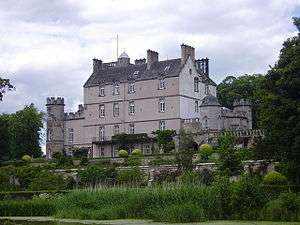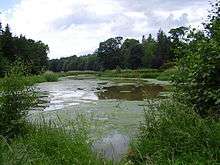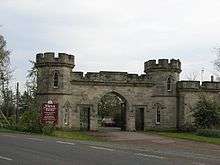Winton House

Winton House is a historic house set in a large estate between Pencaitland and Tranent in East Lothian, Scotland. The house is situated off the B6355 road approximately 0.5 miles (0.80 km) north of Pencaitland at grid reference NT437694
History
The Seton family were granted lands in East Lothian, including Winton, by King David I of Scotland in 1150. In the ensuing years the estate has passed through the hands of several eminent families.[1] The origins of the house date from 1480 when George, 4th Lord Seton, commenced the building of Wintoun Castle, a tower standing 4 stories high,[2] surrounded by a defensive curtain wall. During the War of the Rough Wooing in 1544, Edward Seymour, Earl of Hertford, all but destroyed Wintoun Castle after bombardment and burning.[3]
In 1600, the family were granted the Earldom of Winton and the 1st Earl immediately set about restoration of the castle, although work ceased upon his death in 1603. His son Robert, the 2nd Earl, resigned the title which passed to his younger brother George. George commissioned William Wallace, master-mason to the king, to oversee the completion of the restoration in 1620.[2] The completed house was more palatial than defensive, in keeping with a new confidence after the turbulent 16th century. Prince Charles, the future King Charles I of Scotland and England, was said to have visited Winton House, having been tutored by Alexander Seton, 1st Earl of Dunfermline who resided at nearby Pinkie House. Charles' son, King Charles II also visited the house.[3]
In 1715, when George Seton, 5th Earl of Winton was captured at the Battle of Preston, during the First Jacobite Rebellion. His and his family's support of the exiled House of Stuart led to the Earl's imprisonment in the Tower of London, and his assets, titles and lands were confiscated. The York Buildings Company took over the Seton lands. In September 1745, Prince Charles Edward Stuart requisitioned Winton, to garrison his troops during the next Jacobite Rebellion in 1745, in the name of the Earl of Winton. The Jacobites were victorious at the nearby Battle of Prestonpans, fought on 21 September.[1]

A new era
In 1779, Mrs Hamilton Nisbet of Pencaitland bought the house and estate at Winton. On her death in 1797, the lands were passed to her son Colonel John Hamilton and it was he who further improved the house by employing architect John Patterson.[1] As well as extensive building work on the house, Colonel Hamilton also planted extensively on the estate.[2] Patterson's new neo-Gothic work can still be seen at Winton. The house passed down through females until, in 1846, it came into the hands of Mary, Lady Ruthven, who did much for the village of Pencaitland, including building a new school. She also built a new hamlet, New Winton, to house the estate workers as their houses on the estate were becoming unfit for human habitation. She also carried out many improvements to house and estate. In 1885, the house was passed to Lady Ruthven's cousin, Constance Nisbet Hamilton.[1] Constance married Henry Ogilvy of Inverquarity in 1888. On her death in 1920, Winton House passed to Henry's nephew Gilbert Ogilvy, an architect. Henry, the new Laird of Winton, did much to improve the estate. He removed the Regency extension on the east wing, bridged the 19th-century north castellated lodges,[4] and built the laundry house.[1] He also carried out major work on the land, cutting and ploughing before planting hundreds of new trees.[2] Gilbert Ogilvy died in 1953, the estate passing to his son David, who like his forebears, did much, with his wife Penelope, to improve Winton House and estate. Sir David inherited the Baronetcy from his uncle in 1956 and died in 1992, with Winton passed to his son, Sir Francis Ogilvy, 14th Baronet of Inverquarity, and his wife Dorothy. The loch in front of the house was named in remembrance of Sir David.

Today
Winton House is considered a masterpiece of Scottish Renaissance architecture. It contains ornate and intricate plaster ceilings, fine furniture, family treasures and many paintings by notable Scottish painters.[5] Winton House is a category A listed building.[6]
The house is now an award-winning corporate hospitality, conference centre, meeting venue and team building activity centre. The house has won the World Travel Castle award three times [7] and has a gold Green Business Tourism Scheme award for its environmental approach. Guests can also stay overnight in the rooms in the House or in the luxury, self-catering country houses on the estate.
Gardens
The gardens are terraced to the banks of St. David's Loch and up to the walled garden.[8] There are several routed walkways, open to the public, passing through the estate woodlands and along the banks of the Tyne Water.[9]
References
- 1 2 3 4 5 "Winton House website".
- 1 2 3 4 "Winton House". Inventory of Gardens and Designed Landscapes in Scotland. Historic Scotland.
- 1 2 "Seton Residences".
- ↑ McWilliam, Colin. Lothian, except Edinburgh. The Buildings of Scotland. Penguin. ISBN 0-14-071066-3.
- ↑ "Best Loved Hotels".
- ↑ "Listed building report".
- ↑ "Visit Britain".
- ↑ "Scotland's Garden Scheme".
- ↑ "Walking at Winton".
External links
Coordinates: 55°54′55″N 2°54′02″W / 55.9152°N 2.9005°W